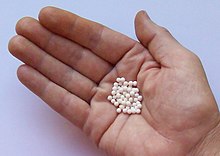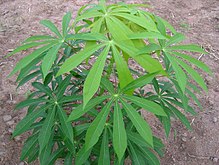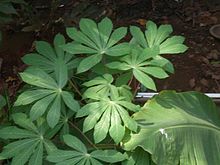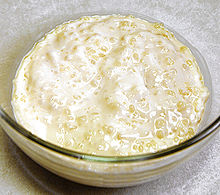This article is about a purified starch product. For use as a root vegetable, see
cassava.
Tapioca (
Portuguese pronunciation: [tɐpiˈɔkɐ]) is a
starch extracted from
cassava root (
Manihot esculenta). This species is native to the
North Region of Brazil, but spread throughout the South American continent. The plant was carried by
Portuguese and
Spanish explorers to most of the West Indies, and continents of Africa and Asia, including the Philippines and Taiwan. It is now cultivated worldwide.
Etymology and origin[edit]
In
Brazil, cassava is called
mandioca or
aipim while its starch is called
tapioca, a word derived from the word
tipi'óka, its name in the
Tupí language spoken by natives when the Portuguese first arrived in the Northeast Region of Brazil.
[1] This Tupí word refers to the process by which the cassava starch is made edible.

Spicy and non-spicy tapioca chips
Production[edit]

Colored, translucent tapioca sticks

Small, opaque pearl tapioca before soaking
Tapioca is one of the purest forms of starch food, and the production varies from region to region.
The
cassava plant has either red or green branches with blue spindles on them. The root of the green-branched variant requires treatment to remove
linamarin, a cyanogenic glycoside occurring naturally in the plant, which otherwise may be converted into
cyanide.
[2] Konzo (also called mantakassa) is a paralytic disease associated with several weeks of almost exclusive consumption of insufficiently processed bitter cassava.
In the North and Northeast of
Brazil, traditional community based production of tapioca is a by-product of
manioc flour production from cassava roots. In this process, the manioc (after treatment to remove toxicity) is ground to a pulp with a small hand- or diesel-powered mill. This
masa is then squeezed to dry it out. The wet masa is placed in a long woven tube called a
tipiti. The top of the tube is secured while a large branch or lever is inserted into a loop at the bottom and used to stretch the entire implement vertically, squeezing a starch-rich liquid out through the weave and ends. This liquid is collected and the water allowed to evaporate, leaving behind a fine-grained tapioca powder similar in appearance to corn starch.
Commercially, the starch is processed into several forms: hot soluble powder, meal, pre-cooked fine/coarse flakes, rectangular sticks, and spherical "pearls".
[3] Pearls are the most widely available shape; sizes range from about 1 mm to 8 mm in diameter, with 2–3 mm being the most common.
Flakes, sticks, and pearls must be soaked well before cooking, in order to rehydrate, absorbing water up to twice their volume. After rehydration, tapioca products become leathery and swollen. Processed tapioca is usually white, but sticks and pearls may be colored. Since old times, the most common color applied to tapioca has been brown, but recently pastel colors have been available. Tapioca pearls are generally opaque when raw, but become
translucent when cooked in boiling water.
Brazil in
South America, Thailand in
Asia, and Nigeria in
Africa are the world's largest producers of cassava. Currently, Thailand accounts for about 60% of worldwide exports.
[4]
Nutritional value[edit]
Flatbreads[edit]
A
casabe is a thin
flatbread made from bitter
cassava root without
leavening. It was originally produced by the
indigenous Arawak and
Carib peoples because these roots were a common plant of the
rain forests where they lived. In eastern
Venezuela, many indigenous groups still make casabe. It is their chief bread-like staple. Indigenous communities, such as the Ye-Kuana, Kari-Ña,
Yanomami, Guarao or
Warao descended from the Caribe or Arawac nations, still make casabe.
[6]

Casabe baking in a small commercial bakery
To make casabe, the starchy root of bitter cassava is ground to a pulp, then squeezed to expel a milky, bitter liquid called
yare. This carries the poisonous substances with it out of the pulp. Traditionally, this squeezing is done in a
sebucan, an 8 to 12-foot (3.7 m) long, tube-shaped, pressure strainer, woven in a characteristic helical pattern from
palm leaves. The sebucan usually is hung from a tree branch or ceiling pole, and it has a closed bottom with a loop that is attached to a fixed stick or lever, which is used to stretch the sebucan. When the lever is pushed down, stretching the sebucan, the helical weaving pattern causes the strainer to squeeze the pulp inside. This is similar to the action of a
Chinese finger trap. The pulp is spread in thin, round cakes about 2 feet (0.61 m) in diameter on a
budare to roast or toast.
Thin and crisp cakes of casabe are often broken apart and eaten like crackers. Like bread, casabe can be eaten alone or with other dishes. Thicker casabe usually are eaten slightly moistened. A sprinkle of a few drops of
liquid is enough to transform a dry casabe into a very soft and smooth bread similar to the softest slice of a
wheat bread loaf. Because of its capacity to absorb liquid immediately, casabe may cause someone to choke, but goes down quickly with a sip of liquid.
In
Guyana, the
casabe is called cassava bread. It is prepared with an instrument called a
matape by the natives of the
Rupununi Savanah and other areas of the country that have a high concentration of Amerinidians. In
Jamaica, it is called
bammy.
In
Brazil, the cassava flatbread is called
beiju or
tapioca.
Tapioca pearls[edit]
Tapioca pearls are also known as
boba in some cultures. It is produced by passing the moist starch through a sieve under pressure. Pearl tapioca is a common ingredient in
Asian desserts such as
falooda,
kolak,
sago soup, and in sweet drinks such as
bubble tea,
fruit slush and
taho, where they provide a chewy contrast to the sweetness and texture of the drink. Small pearls are preferred for use in puddings. In Brazil, those pearls are cooked with wine or other liquid to add flavor, and are called Sagu.
Large pearls are preferred for use in drinks. These large pearls most often are brown, not white (and traditionally are used in
black or
green tea drinks), but today are available in a wide variety of pastel colors. They are also available as an option in
shave ice and hot drinks. In addition to their use in puddings and beverages, a recent innovation has been to cook tapioca pearls inside cakes.
[7]
World War II[edit]
During
World War II, due to the shortage of food in Southeast Asia, many refugees survived on tapioca. The cassava plant is easily propagated by stem-cutting, grows well in low-nutrient soils, and can be harvested every two months, although it takes ten months to grow to full maturity. The plant provided much needed carbohydrates and other nutrients during wartime.
[8]
Biodegradable products[edit]
Laundry[edit]
Regional applications[edit]
South America[edit]
In
Brazilian cuisine, tapioca is used for different types of meals. In beiju (or biju), the tapioca is moistened, strained through a sieve to become a coarse flour, then sprinkled onto a hot griddle or pan, where the heat makes the starchy grains fuse into a flatbread which resembles a grainy pancake. Then it may be buttered and eaten as a toast (its most common use as a breakfast dish), or it may be filled or topped with either
salgados (salty pastry recipes) or
doces (sweet pastry recipes), which define the kind of meal the tapioca is used for: breakfast/dinner, or dessert. Choices for fillings range from butter, cheese, ham, bacon, various kinds of
meat,
chocolate,
fruits such as ground coconut,
condensed milk, chocolate with sliced pieces of banana or
strawberry, among others. This kind of tapioca dish is usually served warm.
A regional dessert called sagu is also made in Southern Brazil from tapioca pearls cooked with cinnamon and cloves in red wine. The cassava root is known by different names throughout the country: mandioca in the North, Central-West and in São Paulo; tapioca or macaxeira in the Northeast; aipim in the Southeast (especially in Rio de Janeiro).
The fine-grained tapioca starch is called
polvilho, and it is classified as either "sweet" or "sour". Sour
polvilho is commonly used in dishes such as [[
pão de queijo]] or "cheese bread", in which the starch is mixed with a hard cheese, usually matured
Minas cheese (could be substituted by
Parmesan cheese), eggs and butter and baked in the oven. The final result is an aromatic, chewy and elastic kind of bread that is ubiquitous across the country. Sour cassava flour is mixed into mashed beans to make the dish
tutu de feijão.
Other locations[edit]
In
Colombia and
Venezuela,
arepas may be made with tapioca flour rather than cornmeal. Tapioca arepas probably predate cornmeal arepas
[citation needed]; among traditional cultures of the Caribbean the name for them is
casabe. Throughout both Spanish and Portuguese South America, the tapioca, or yuca, starch is used to make regional variations of the baked
cheese bun, known locally as
pandebono,
pan de yuca,
pão de queijo,
chipá, or
cuñapé, among other names.
The whole unprocessed
cassava root also has a number of culinary uses throughout South America.
North America[edit]
While frequently associated with
tapioca pudding, a dessert in the United States, tapioca is also used in other courses.
[9] Bubble tea, made with tapioca pearls, is gaining popularity in cities with large Asian populations. People on
gluten-free diets can eat bread made with tapioca flour (although these individuals have to be careful, as some tapioca flour has wheat added to it). Tapioca is also used as an ingredient in the Canadian
Daiya brand
cheese substitute.
West Indies[edit]
Tapioca was used by the first inhabitants of the West Indies as a staple food from which they made main dishes, such as pepper pot, and also used it to make alcohol. They used it for teeth cleaning, and it is still used as a base locally for toothpaste. In the 21st century, it is still a very popular food in the islands, used as a provision cooked with meats or fish, and in desserts such as cassava pone.
[citation needed]
In various Asian countries, including Indonesia, China, Thailand, Vietnam, India, Pakistan, Bangladesh, Myanmar, Philippines, Malaysia, and Taiwan, tapioca pearls are widely used and are known as sagudana,
sabudana or shabudana (pearl sago) or "sabba akki" (ಕನ್ನಡ: ಸಬ್ಬಕ್ಕಿ in
Kannada). It has religious importance in certain communities and used as a staple food for fasting. The pearls (sagudana or shabudana/sabudana) are used to make snacks. Tapioca pearls are essential ingredients for Taiwanese
Bubble Tea.
Southeast Asia[edit]

Tapioca chips, baked in sand
In Southeast Asia, the cassava root is commonly cut into slices, wedges or strips, fried, and served as a snack, similar to
potato chips,
wedgesor
french fries. Another method is to boil large blocks until soft, and serve them with grated
coconut as a dessert, either slightly salted or sweetened, usually with
palm sugar syrup. In Thailand this dish is called Mansampalang (มันสำปะหลัง).
Tapai is made by fermenting large blocks with a yeast-like bacteria culture to produce a sweet and slightly alcoholic dessert. Further fermentation releases more liquids and alcohol producing
Tuak, a sour alcoholic beverage.
A variation of the chips popular amongst the
Malays is
kerepek pedas, where the crisps are coated with a hot, sweet and tangy
chili and
onionpaste, or
sambal, usually with fried
anchovies and
peanuts added.
Krupuk, or crackers, is a major use of tapioca starch in Indonesia.
Commercially prepared tapioca has many uses. Tapioca powder is commonly used as a thickener for soups and other liquid foods. It is also used as a binder in
pharmaceutical tablets and natural paints. The flour is used to make tender breads, cakes, biscuits, cookies, and other delicacies (see also
Maida flour). Tapioca flakes are used to thicken the filling of
pies made with fruits having a high water content.
A typical recipe for tapioca jelly can be made by washing 2 tablespoonfuls of tapioca, pouring a pint of water over it, and soaking for three hours. The mixture is placed over low heat and simmered until quite clear. If too thick, a little boiling water can be added. It can be sweetened with white sugar, flavored with coconut milk or a little wine, and eaten alone or with cream.
Sri Lanka[edit]
It is known as "Mangnokka" in
Sri Lanka and
Mauritius, as well as by its Sinhalese and Tamil names. It is generally eaten boiled with a chili onion mixture called "Lunu Miris Sambol" (type of a salsa) or coconut
sambol. At the same time, it is very popular to have tapioca pearls prepared as a delicacy. At one time, tapioca pearls were used to starch clothes by boiling tapioca pearls with the clothes.
Bangladesh and Bengal province (India)[edit]
During
religious fasts, sabudana is a popular alternative to rice-based foods. Consumed with curd or milk or prepared as a
Khichdi, sago is particularly popular choice during the fasts of 'Ramadan','Ombubachi', Nilshosthi and
Ekadoshi. Traditionally, tapioca pearls are used as the food for children, elderly and ill people, mixed with milk or water. Faluda, a popular food, is also prepared with curd, ice and other ingredient during summer.
Tapioca is a common ingredient of some Indian dishes and the most common form that is added into dishes is in the form of Tapioca Pearls. Local words for Tapioca roots in India include:
Odia Sagudana,
Malayalamkappa or
maraccīni,
Tamil maravaḷḷikilanku,
Kannada sabakki(ಸಾಬಕ್ಕಿ)', Hindi (साबूदाना)
and saggu biyyam (సగ్గు బియ్యం)
Telugu language. which used to prepare sabbakki payasam in indian traditional foods
Cassava, often referred to as tapioca from its word in Portuguese, is called Kappa (കപ്പ) Kizhangu or (in northern Kerala) or Maracheeni or Cheeni or Kolli or Mathock (മത്തോക്ക്), Poola (പൂള) in
Malayalam.
Tapioca is widely consumed in the Indian state of
Kerala, usually as breakfast or in the evening. It is boiled (after skinning and cutting it into large cakes of about 6–8 cm (2.4–3.1 in) long or into small 2 cm (0.79 in) cubes) in water till properly cooked, and the water is drained off. Once cooked, it can be mixed with grated coconut, chili, salt, turmeric etc., then steamed and mashed into a dry pudding. This can be garnished in oil with mustard, onion, curry leaves etc. if desired. Tapioca cakes (Chendan Kappa) are often eaten with simple chili sauce (a paste of Green/Red Chili + Shallot + small red Onion + Garlic + Salt + Oil).
Mashed Tapioca is paired with Meat / Fish curry. Tapioca with fish curry (especially sardines) is a delicacy in Kerala. Mashed Tapioca with Chutta Unakka Mathi (dry salted sardine directly cooked on charcoal) and Green Chili is another popular combination. Kappa Biriyani is yet another Tapioca dish.
Tapioca can be stored for longer periods by parboiling and drying it, after skinning and slicing it into 0.5 cm thick pieces. This is called Unakka Kappa or Vaattu Kappa (dried tapioca). Unakka Kappa pudding is widely consumed in Kerala. Tapioca Chips, thinly sliced tapioca wafers, similar to potato chips, are also popular.
Tamil Nadu[edit]

Cassava plant in early stage
In
Tamil, the roots of tapioca are called
Maravalli Kilangu, and are used to prepare chips. Tapioca chips are also prepared in parts of South India. Tapioca pearls are referred to as "Javvarisi" in Tamil. Most of the delicacies are cooked from this form of tapioca because it is relatively easier to handle than the raw root by itself. In
Tamil Nadu, tapioca is cultivated more in several districts, providing steady income to farmers. Tapioca can be consumed raw (after removing the skins/outer cover) or boiled for various dishes or snacks.
Northeast India[edit]
In
Nagaland and
Mizoram in
Northeast India, tapioca is eaten as a snack. It is usually boiled with a bit of salt in water after skinning it, or snacks are made by drying the tapioca after cutting it. It is then powdered into flour and turned into dough to either make a fired or baked biscuit. In their local dialect, they call it
kuri aloo, meaning "wood potato". These chips are eaten by all groups of society as a delicacy. The skin of the tapioca, which is not edible for humans, is kept aside to prepare a food for domesticated pigs. In Assam, sabudana is also used as substitute diet against boiled rice (bhaat) for the sick elderly or infirm for easy digestion and strength.
Tapioca is eaten in the regions of
Nigeria and
Ghana as the everyday-man's meal, and is usually taken for breakfast. The various tribes use it in multiple dishes.
[citation needed]
Cassava is a staple food in West Africa where it is widely eaten. In Nigeria cassava is grated and dry roasted into 'gari', this is eaten by adding water, sugar and or peanuts accompanied by meat or smoked fish. Gari is also made into 'eba' by adding hot water, this is eaten with stew or soup. The 'Ijebu' tribe of Nigeria make a cold water variant of eba by pounding the mixture with their fist until it becomes homogenous, this is called 'feshelu'. The Egbas of Abeokuta Ogun State peel, dry and grind cassava into a powder called 'elubo', this is made into 'amala paki', this is eaten with jute leaf stew called 'ewedu'.
In Lagos cassava is processed into tapioca which is cooked in coconut milk and sugar, this can be eaten as a breakfast meal or as a dessert at parties or dinner. This is called 'mengau'.
The Igbos of Eastern Nigeria add palm oil to grated cassava during roasting, this is called 'yellow gari'.
The tribes in Niger Delta extract starch from cassava, this is cooked into a glutinous meal called 'starch', it is eaten with 'pepper soup'.
In Ghana, cassava is peeled, boiled until tender, then pounded in a large wooden mortar and pestle until it becomes homogenous, this is called 'fufu', it is eaten with soup.
Tapioca is not as widely used in Europe, but several countries make use of tapioca. In Belgium, small white tapioca pearls are added to clear soups. Tapioca balls are used in French desserts, such as parfaits. The savory snack in the United Kingdom,
Skips, are made of tapioca and flavored like
prawn cocktail, as well as other flavors.
Tapioca is also widely available in its dried forms and is used to make
tapioca pudding.












